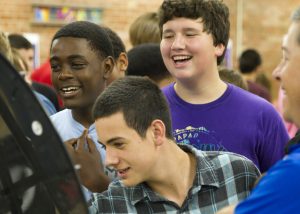Merrill Students Find Many Options for Service
Middle schoolers roaming malls in packs aren’t an uncommon sight. But when the “mall” is the school cafeteria and the “shops” are displays set up by area non-profits looking for help, deliberate attention is called for.
That was the scene at Merrill this morning at the school’s 5th annual Service Learning Fair.
The day began with an assembly in the auditorium where the 8th graders were briefed on the ways and means of fulfilling the community service component of their International Baccalaureate curriculum. Each of them must log 10 hours over the course of the year at an agency of their choosing from a long list of certified service providers. 21 of them were represented at Merrill this morning, ranging from the Animal Rescue League to the Young Women’s Resource Center.
During the assembly the spiritual pump was primed by a video that demonstrated many of the ways that little acorns of volunteerism, ranging all the way back to Ben Franklin’s establishment of the nation’s first volunteer fire department, have grown into mighty organizations like Habitat for Humanity, Doctors Without Borders and the Peace Corps.
Math teacher Robert Randazzo warned all those not exactly fired up to pitch in that they were in for a pleasant surprise. He recounted his own adolescent baptism as a volunteer when he raised his hand to help out with the Special Olympics. There was a free meal at McDonalds in it for him, plus his girlfriend was into it. That was more years ago than Mr. Randazzo can believe. McDonalds isn’t quite the special treat he thought it was back then and the girlfriend is long gone, but his association with Special Olympics endures.
The idea is to plant a lot of civic seeds that will grow into full-blown citizenship as the kids grow into adulthood. According to social science teacher Dave O’Connor, the coordinator of the event whose own parents insisted that he be involved in community service when he was a boy, some variation of Mr. Randazzo’s experience is in store for many of the students, whether they believe it or not.
“Oh yeah, every year lots of kids end up far exceeding the 10 hour quota,” he said. “They kind of tiptoe in and then they get hooked on whatever kind of service they try.”
The projects have four elements and must be completed by next May:
- Research/rationale on the chosen activity
- Action plan with specifics
- Verification of service
- Reflection upon completion of service
Once the pep talk was over and the thundering herd of do-gooders adjourned to the cafeteria/mall it didn’t take long for Emma Hildebrandt and Lydia Berry to make up their minds. Within minutes they were signing up with Gigi’s Playhouse, an organization that raises awareness of Down’s syndrome and supports families that deal with it. Their reason? “We’ve heard from friends that it’s a good thing,” Emma explained. Word gets around. One good turn leads to another.
There are four school-based projects that are approved service opportunities. Meals From the Heartland, Merrill’s own in-house recycling program, Soles for Souls (an organization that collects and delivers shoes to high-poverty areas) and the school’s annual holiday food drive always draw lots of participants.
There are 248 8th graders at Merrill this year. Times ten, that’s a minimum of almost 2,500 hours’ worth of helping hands extending into the community that wouldn’t otherwise. Chambers of commerce like to tout the economic impact of big events on their communities. But how do you measure the impact of something like this? And how long does it last?
Sometimes, a lifetime – right, Mr. Randazzo?





